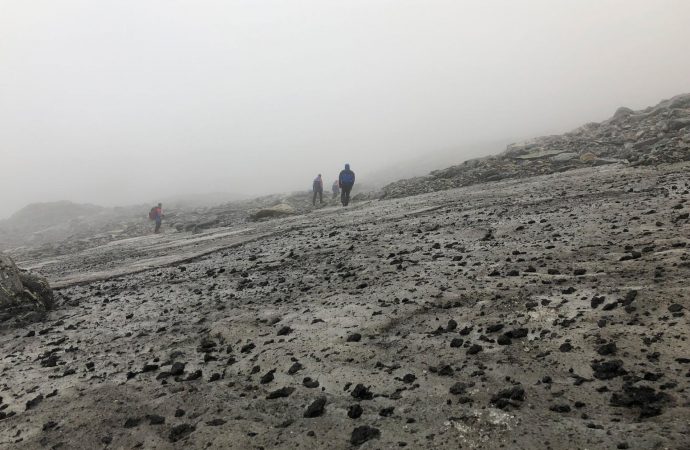1,000-year-old horseshoes, sleds, and tools are emerging from a shrinking ice patch in Norway, telling the story of the rise and fall of a mountain pass and the people who traveled along it.
Source: National Geographic
It started with an 1,800-year-old shirt. Archaeologist Lars Holger Pilø had watched his colleagues discover the ancient wool tunic that had emerged from a melting ice patch on Lomseggen, a mountain in southern Norway. Now Pilø wondered what else was out there. As the rest of the team packed up the precious find, he and another archaeologist wandered away from the group, tracing the edge of the melting ice shrouded in mountain fog.
As he peered into the gloom, Pilø soon realized he was looking at a field of objects that hadn’t seen the light of day for hundreds of years. Broken sleds, tools, and other traces of daily life going back nearly 2,000 years lay strewn across the surface of the Lendbreen ice patch, which was melting rapidly due to global warming.
“It dawned on us that we had found something really special,” says Pilø, who leads the Glacier Archaeology Program in Oppland, Norway. “We sort of hit the motherlode.”
Now, research published today in the journal Antiquity documents what came next—the discovery of more than 1,000 artifacts literally frozen in time.
Dating from around 300 to 1500 A.D., the artifacts tell the story of a mountain pass that served as a vital travel corridor for settlers and farmers moving between permanent winter settlements along the Otta River in southern Norway and higher-elevation summer farms farther south. And as they traveled across the rough terrain, these bygone travelers left behind everything from horseshoes to kitchen tools to items of clothing. As snow collected over the centuries, those forgotten objects were preserved in what eventually became the Lendbreen ice patch.
Ice patches are located at high elevations, but they aren’t the same as their larger cousins, glaciers. Objects frozen in glaciers are eventually pulverized inside the moving mass of ice. But ice patches, which do not move, preserve artifacts in place—and in excellent condition—until the ice melts.
Pilø, the first author on the Antiquity paper, and his colleagues have radiocarbon dated 60 of the 1,000 Lendbreen artifacts so far, revealing that human activity on the pass began around 300 A.D., during a time when good climate conditions led to a population boom in the area. Travel during the Viking Age peaked around the year 1000, and, owing to economic and climactic changes, had begun to decline even before the Black Death swept through Norway in the 1340s.
Mystery artifacts with modern explanations
The objects found at Lendbreen include everyday items such as sleds, a rare complete third-century wool tunic, a mitten and shoes, and a whisk. One of Pilø’s favorite finds was a mystery until it went on display at the local museum and an elderly woman offered an explanation: The small, turned piece of wood was likely used as a bit to prevent a goat kid or lamb from suckling its mother so people could use the milk for themselves, she explained.
The woman, who had lived on a summer farm during the 1930s, said that her family used bits fashioned from hard juniper wood that looked almost identical to the 11th-century artifact. The thousand-year-old bit turned out to be made from juniper, too.
It also appears that the Lendbreen pass wasn’t just a local pathway for farmers moving back and forth between seasonal pastures. Pilø’s team discovered multiple cairns—stacked rock formations designed to help people who were unfamiliar with the terrain find and navigate the pass on longer journeys throughout Scandinavia. The presence of cairns, along with the discovery of horseshoes (and even a horse snowshoe), is “very convincing” evidence the ice patch was used as a busy travel artery for almost 1,000 years, says Pilø, making the Norwegian site the first such pass discovered in Northern Europe. Today’sPopular Stories
Albert Hafner, a glacier archaeologist at the University of Bern who was not involved with the current research, agrees. “I think the arguments are quite clear,” he says. In 2003, Hafner discovered hundreds of artifacts dating as far back as 4800 B.C. at Schnidejoch, an ice patch in the Swiss Alps that was also used as a mountain passage. “It’s quite interesting to have a similar site in Scandinavia,” says Hafner.
The current paper focuses on objects uncovered by 2015, which leaves hundreds more artifacts to date and describe—as well as unanswered questions about why the pass was abandoned by travelers. “The decline starts before the [Black Death] pandemic, but we don’t have a good explanation for that,” says Pilø. But the peak years of the pass line up with a time of increased trade and urbanization in the area—prosperous days that explain the need for a quick way to get through the mountains.
Work at Lendbreen ended in 2019, and Pilø, is now in search of other objects being revealed by massive melting throughout Norway’s fragile ice patches. Artifacts “are basically being stored in a giant prehistoric deep freezer,” Pilø says. “They have not aged. I sometimes jokingly say that the ice is a time machine, but it’s not only a joke. It transports the artifacts to our times.”
But for that to happen, the ice must melt. And with Norway’s cryosphere already slipping away in the face of climate change and a series of punishingly hot summers, every seemingly miraculous find is bittersweet.
“We try to focus on the work when we operate, but it just keeps coming up,” says Pilø. “It’s not a job you can do without a great sense of foreboding.”
Source: National Geographic

































Leave a Comment
You must be logged in to post a comment.